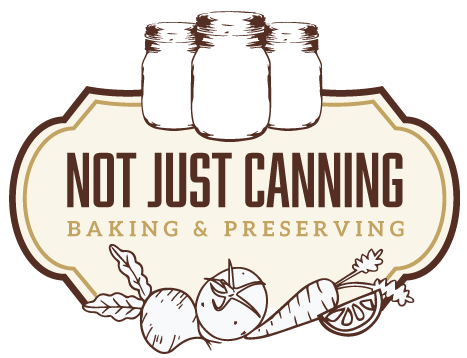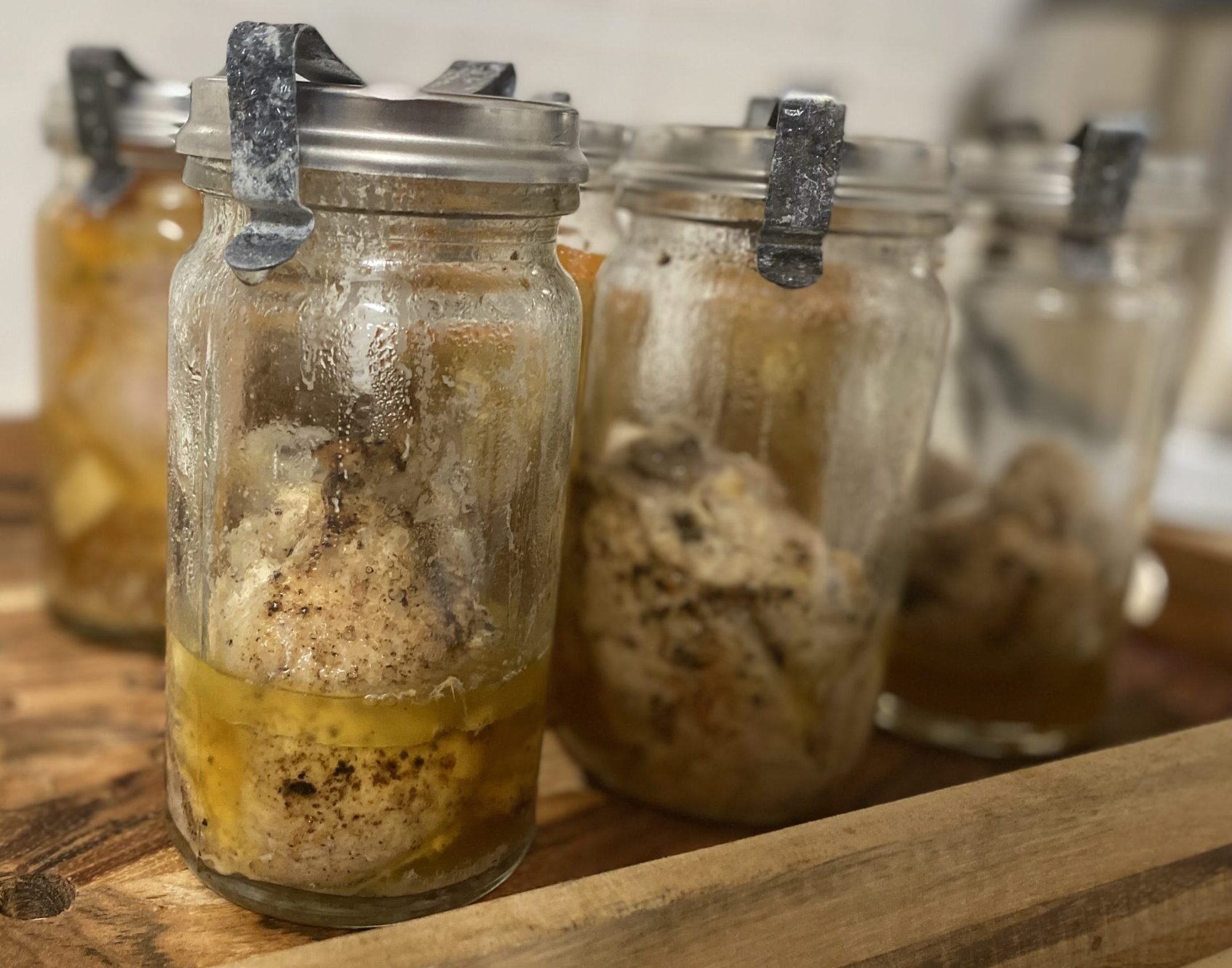Sometimes it is the simple additions to a dish that make it stand out. As tempting as it can be while canning meats to just throw it in, process it, and flavour it later, it is a lot nicer to have some tasty seasoned and versatile chicken to use in many different ways.
Only an extra 15 minutes or so and your chicken goes from plain to filled with flavour.
Having onion and garlic powder already on the cutlets, and a quick browning in the pan, makes this a delicious treat that can be enjoyed straight from the jar.
If you are going for a picnic just grab a jar of these cutlets and some rolls. Throw it on a tray with the juices from the jar and you will have the most tender roast chicken pieces, ready to eat in 30 minutes or less with only a jar and tray to clean.
You could add any spices that you want. Paprika, oregano, sage, and many others go well with chicken. I have kept it very basic so that it can be used in pretty much any chicken dish.
To keep the clean up to a minimum, I sprinkled the cutlets with the seasonings while it was in the tray. Once the pan was heated i added the cutlets with the seasoning down then coated the other side. It doesn't need to be a perfect coating, and you can add as much or as little as you like of each.
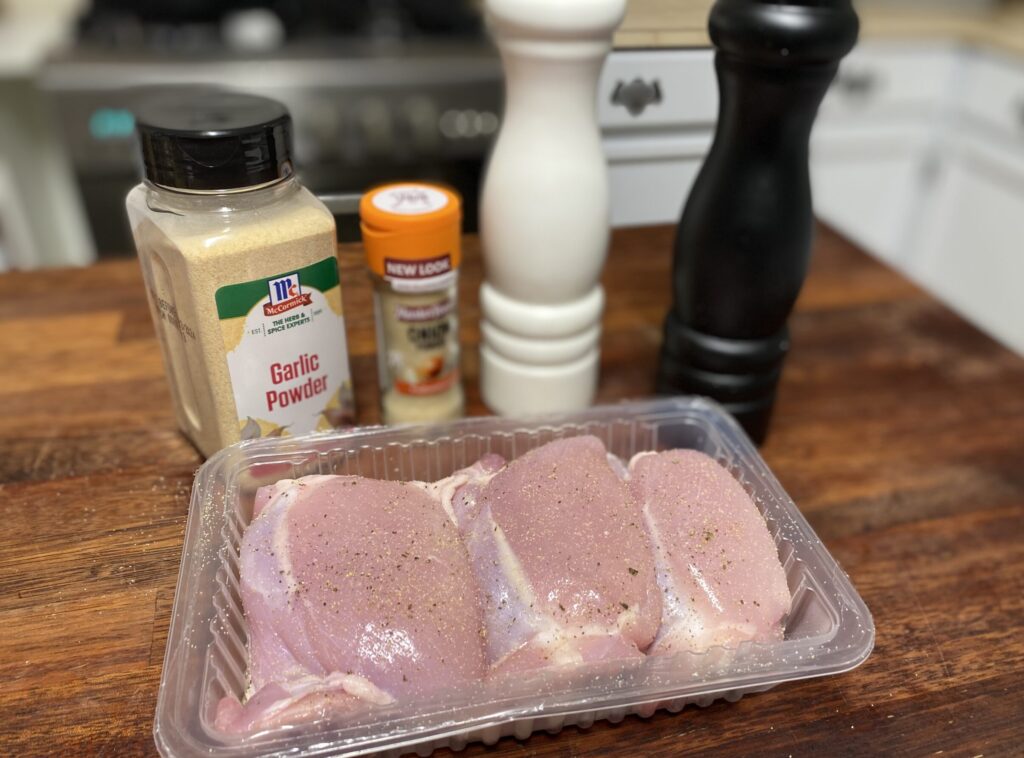
Browning the cutlets gives it a nice flavour after processing, however if you skip this step they will still process the same. When browning it is important to make the pan hot, the goal is to have it brown as fast as possible.
The goal is to get the flavour without the juices from the meat being cooked out.
Once they are browned on both sides, place them on a plate in the fridge until you are ready to pack them into jars.
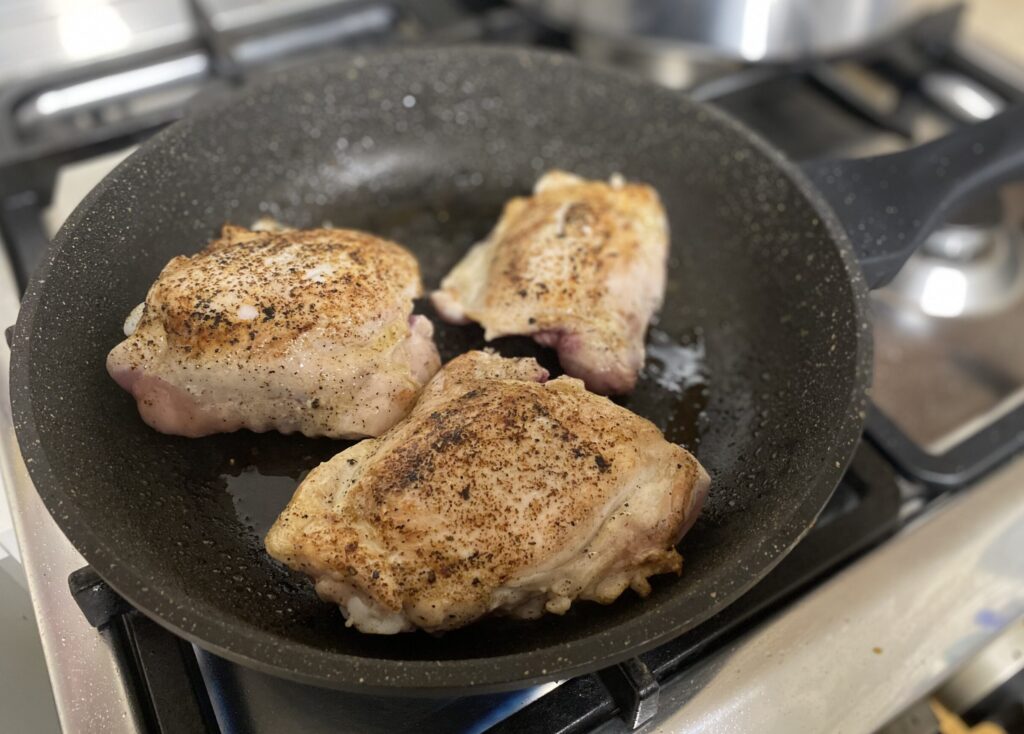
Choose your jar size according to how many you would like to fit in. Remember that it will need to be eaten within a few days of opening.
These jars were made so that I could have a bit of shredded chicken for some sandwiches, so i only put one into each. They are 600ml Fowlers jars and they will fit 2-3 cutlets, depending on the size of the cutlets.
Once your chosen jars are washed and ready, use some tongs, fork, spoon or your hands to help get them into the jars. It may be a tight fit and make a mess of the jar rims.
Make sure you leave a 1 inch headspace in each jar, if it is too close to the lid the seal may fail due to food particles leaking out during processing.
Take some paper towel and wipe the bulk of the mess away. Then with a fresh piece with a little vinegar, wipe around the rim of the jar. Mason jars seal on the very top rim of the glass, Fowlers jars seal around the edge. Your goal is to remove any food, liquid and fat from these areas.
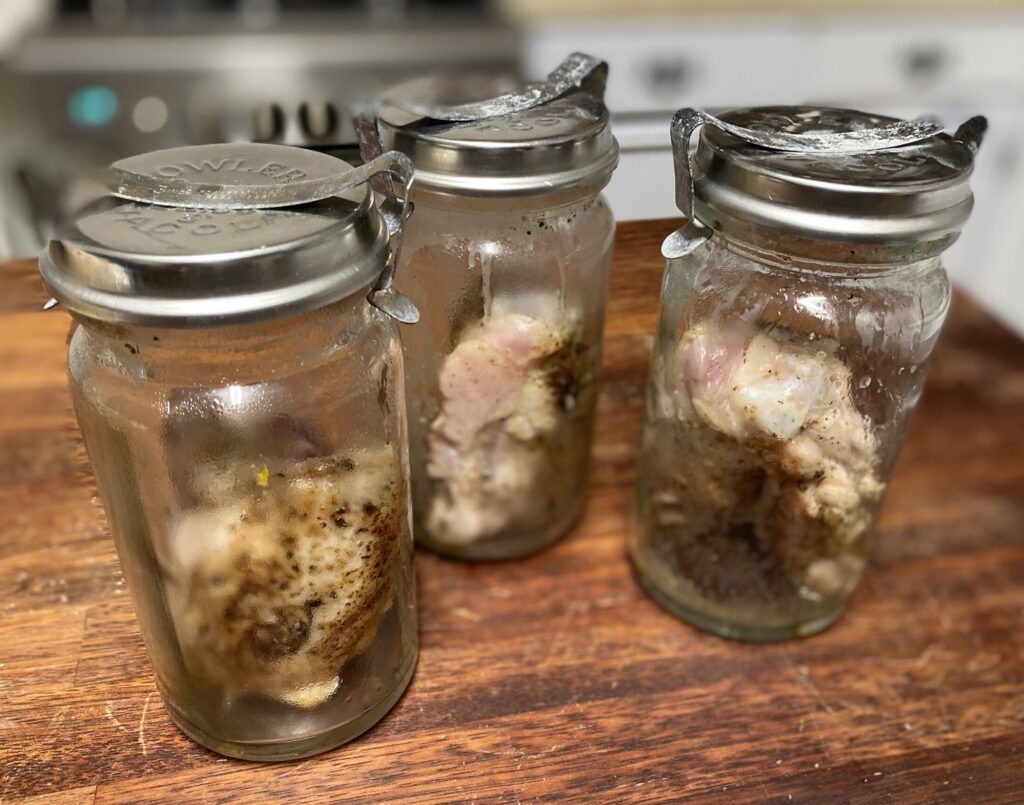
If using Mason jars with lids and rings place the lid and do up the ring finger tight. Use only your fingertips to tighten, otherwise the lids may buckle from the pressure.
If using Fowlers jars, place the rubber seal around the lip, add the lid then carefully place the clip across the center of the lid. Put one side of the clip in place then while holding the jar and the clip in place, stretch the other side over and into position.
Carefully place jars into the canner, the amount of jars that fit inside depends on the model. however keep in mind that the guide to how many jars is based on standard Mason jars. Fowlers jars take up more space due to the clips, so not as many will fit.
Ensure that the jars are not touching each other. If there is extra space for more, you could either add something else in a jar to process, or jars of water to prevent tipping.
A splash of vinegar to the water in the bottom of the canner will help keep your jars clear, otherwise they will come out cloudy. This will not effect the quality of the food, only the look of the jar for storage.
Close up the canner leaving the pressure regulator off, and turn the heat on. Once it is heated and steam is coming out the vent, start a timer for 10 minutes. When the timer is up add the pressure regulator to the correct pressure for your altitude (10lb for under 1000ft, 15lb for over 1000ft)
When the canner has reached pressure the regulator will 'jiggle' and release some steam. Start a timer for the processing time and adjust the heat so that it only 'jiggles' a few times a minute. You will get to know your stove and how high of heat it requires to hold pressure.
Be sure to keep it as stable as possible. Too much fluctuation in pressure can result in siphoning, which is when the contents of the jar leak out.
The time for processing is dependent on the size of the jar.
500ml (pint) 65 minutes
1000ml (quart) 75 minutes
Fowlers jars have other sizes as well, these are the sizes and times that I use.
Size 20, 600ml (pictured) 67 minutes
Size 26, 900ml 73 minutes
Size 31, 1000ml 75 minutes
Once the time is up, turn the heat off and allow the canner to depressurize naturally. Do not remove the pressure regulator until gauge reads zero pressure. Then remove the regulator and let it vent the steam out for 10 minutes before removing the lid.
Remove jars from canner using a jar lifter. If you do not have a jar lifter you can very carefully lift them out using oven mitts, be careful of steam and any hot liquid on the jars as it may soak through. Ensure that you do not knock the jars together as they are still under a lot of pressure.
The jars will need to cool down on the bench, I like to put them on a wooden surface so that there is no temperature shock. Keep some space between the jars for airflow.
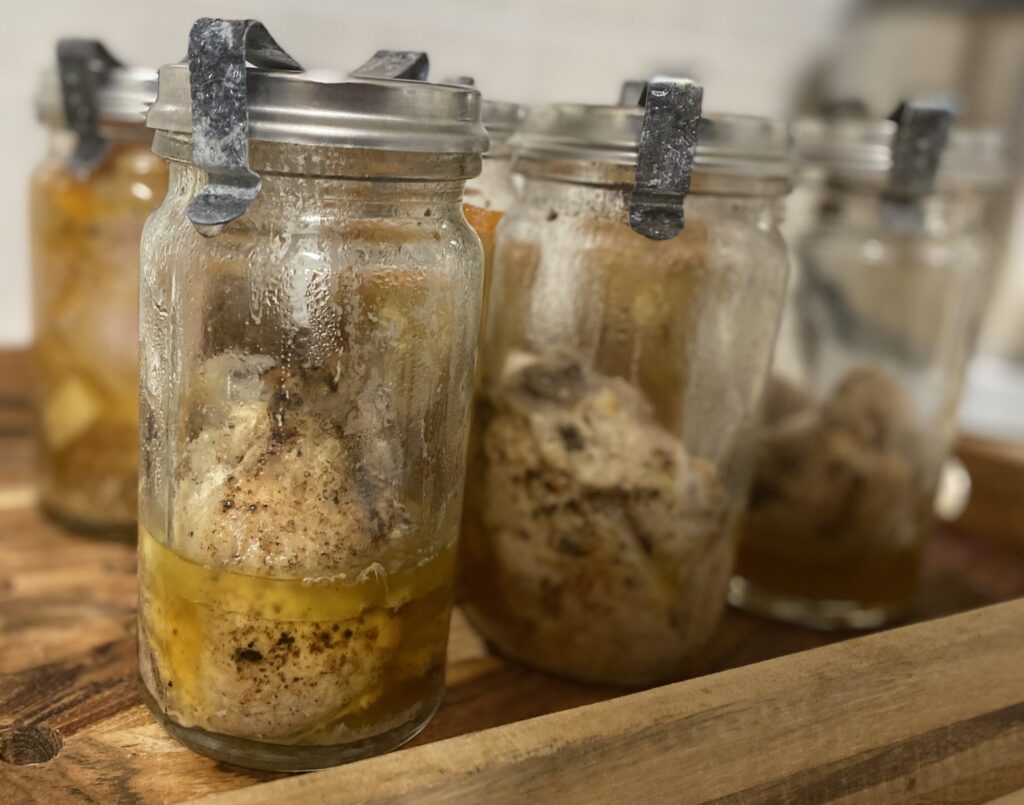
Leave jars untouched for 12-18 hours, then remove the rings/clips and check that they are sealed. Press on the lid to check that there is no movement, it should be pulled down from the vacuum seal. If they have sealed you will be able to pick them up by the lid.
Label your jars with the contents and the date they were processed, after a while and a few different batches it can be difficult to remember what is in each jar.
Store jars in a single layer, if the seal fails at all you want to know it has. If they are stacked, they may create a false seal after air gets in which would spoil the contents.
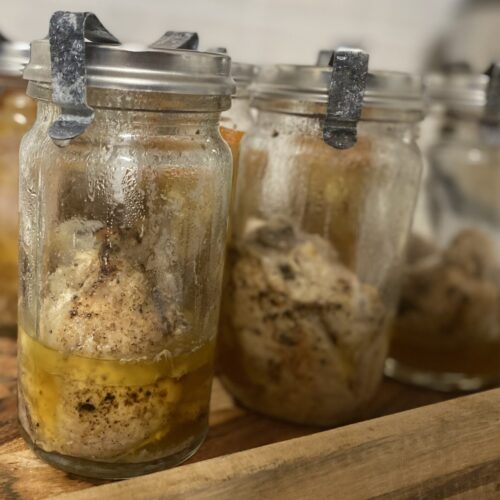
Canned Seasoned Chicken Cutlets
Equipment
- 1 Pressure Canner
- Canning Jars
Ingredients
- chicken cutlets, skin off 2-4 per jar depending on size
- onion powder to taste
- garlic powder to taste
- salt to taste
- pepper to taste
- oil for frying
Instructions
- Sprinkle cutlets on both sides with onion powder, garlic powder, salt and pepper to taste.
- Heat a large frying pan with oil over high heat, add cutlets and brown on both sides. place on a plate and put into fridge to cool.
- Prepare Pressure Canner as well as any jars, lids and seals required. Set jars out on benchtop ready for filling. The amount of jars depends on how many cutlets you want in each.
- Divide the chicken between jars using tongs to help, If the pieces wont fit through the rim, just chop of one side off the cutlet next to the bone and put them in separately.
- Once the jars are packed, take a paper towel damp with some white vinegar and wipe down the rim of the jars to remove anything that may interfere with the seal. Place the lids and lower the jars into Canner. If there is space for more jars, you can add jars filled with water to prevent them from tipping during processing.
- Add the lid and bring the Canner to boil until steam comes out the top in a steady stream for 10 minutes. Add the pressure regulator weight (10lb for under 1000ft elevation and 15lb for over 1000ft elevation) and let the Canner come to pressure and the weight jiggles.
- Start timer according to size of jar. 65 minutes for 500ml (pint) and 75 minutes for 1L (quart)
- Once timer is finished, turn heat off and follow manufacturers instructions for de-pressurization.
- Remove jars from Canner and place on wooden board for 12-18 hours.
- Remove rings/clips and check to make sure they have sealed. If there is any residue on the jars give it a clean with a cloth and some warm soapy water then label your jars with the contents and date processed. Store in a single layer, do not stack.
